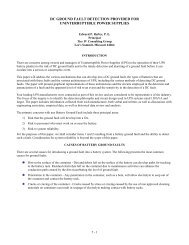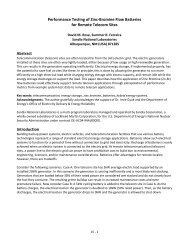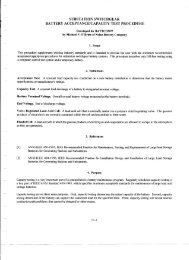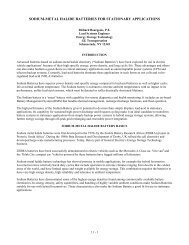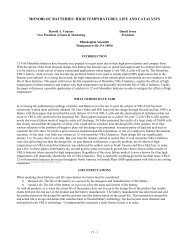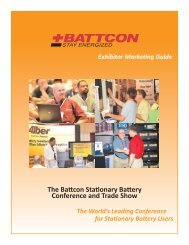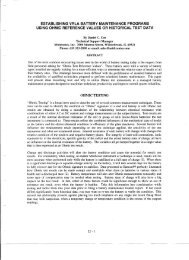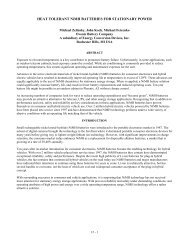FLOODED (VLA ), SEALED (VRLA), GEL, AGM TYPE, FLAT PLATE ...
FLOODED (VLA ), SEALED (VRLA), GEL, AGM TYPE, FLAT PLATE ...
FLOODED (VLA ), SEALED (VRLA), GEL, AGM TYPE, FLAT PLATE ...
You also want an ePaper? Increase the reach of your titles
YUMPU automatically turns print PDFs into web optimized ePapers that Google loves.
Both batteries are qualified for a 20 year period. The tubular battery has a 30% longer service life. This is also confirmed by<br />
the float current measurements. For the tubular batteries, the float current at 2,23Vand 62,8°C doubled from 220mA/100Ah<br />
to 443mA/100Ah in 20 years, while the float current of the flat plate batteries tripled under these conditions from<br />
193mA/100Ah to 567mA/100Ah, which allows in both cases a yearly watering period over the whole lifetime. In both cases,<br />
the low antimony alloy PbSb1.6Se0.04 has selenium as a grain refiner in it. The lower corrosion behaviour of the tubular<br />
batteries is due to the tubular design and also due to the different casting technique: The tubular grids are made with a<br />
110 bar pressure unit, thus avoiding voids and cracks nearly completely.<br />
The positive results of the accelerated lifetime test are confirmed in practice: In European central telecom stations, low<br />
antimony tubular plate batteries are normally 20 years or more in service, depending on the brand.<br />
Cycle life experiments according to IEC 60 896-1 were made with both types. The results are summarized in the table below.<br />
Table 2 Endurance data of <strong>VLA</strong> flat and tubular batteries<br />
Flat plate OGi<br />
Tubular plate OPzS<br />
On float with 2,23V at 62,8°C 425 days 550 days<br />
IEEE 535-1986<br />
21,3 years at 25°C 27,5 years at 25°C<br />
33 years at 20°C 42,7 years at 20°C<br />
Float current increase in 20 years Factor 2 Factor 3<br />
Cycles according to IEC 60 896-1<br />
80% DOD<br />
1200 1800<br />
COMPARISON OF <strong>VRLA</strong> AND <strong>VLA</strong> BATTERIES<br />
Besides performance and endurance data, the <strong>VRLA</strong> batteries provide characteristics which may be of interest in some cases:<br />
• The hydrogen gas evolution during float is reduced by a factor of 10. The ventilation of the battery room may be<br />
reduced by a factor of 5 according to the safety standard EN 50 272-2.<br />
• No acid protection of the floor and other surfaces in the battery room is required. But acid bins underneath the <strong>VLA</strong><br />
battery solves the request.<br />
• Handling acid during density measurements is not required.<br />
• Procurement of purified water and potential impurity problems are avoided.<br />
• No cell failures, like short circuits between the plates, due to mud reduced to lead (“mossing”).<br />
Other characteristics of <strong>VRLA</strong> designs bear significant disadvantages:<br />
• Oxygen ingress through leakages in the container, lid or pole bushing discharges the negative plate.<br />
• The polarization of the negative plate is reduced due to oxygen recombination on the negative plate. In unfavourable<br />
cell designs, the negative polarisation is lost and the negative plate discharges (PCL 3 effect), although the float<br />
voltage is above open-circuit.<br />
• To avoid drying out, the maximum operation temperature is reduced from 55°C to 45°C.<br />
• <strong>VRLA</strong> cells do not allow the same inspection possibilities such as acid density measurements and visual inspection,<br />
so the awareness of a full functioning battery is reduced.<br />
Performance comparison<br />
Here we refer to the <strong>VRLA</strong> <strong>GEL</strong> design. In the next section, we will compare <strong>VRLA</strong> <strong>GEL</strong> with <strong>VRLA</strong> <strong>AGM</strong>.<br />
We use <strong>VRLA</strong> batteries in the 310Ah region having the same size as the small <strong>VLA</strong> batteries in Table 1. So we can easily<br />
compare the performance data.<br />
6 - 5



